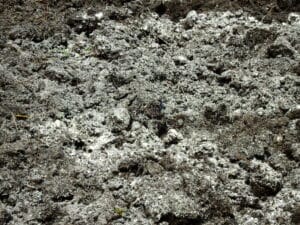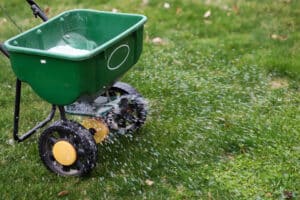Mushrooms can quickly spread, disrupting your yard’s well-kept appearance and potentially posing a hazard to children and pets. The good news is that most lawn mushrooms aren’t harmful. They’re a sign of healthy soil and typically emerge in damp, shaded areas. When your lawn creates the ideal conditions—moisture, organic material, and low light—the underground fungus thrives and produces mushrooms above the surface. Still, most homeowners would prefer not to see these white or gray caps popping up in their grass.
There are effective ways to remove lawn mushrooms and keep them from returning. This guide will walk you through how to identify common lawn mushrooms, why they appear, and what you can do to get rid of them for good.
Get a Quote From Lawn Professionals Near You
Compare quotes from local pros

Lime Soil Amendment

Lawn Fertilization
Identifying Lawn Mushrooms
Mushrooms come in many shapes and sizes. They may be white, gray, or various shades of brown. While there are thousands of known mushroom species, not all are common in lawns. Correctly identifying the mushrooms in your lawn is important for choosing an appropriate removal method.
Some of the most common lawn mushroom species are easy to identify due to their appearance and growing patterns:
- Death cap mushrooms (Amanita phalloides): Native to Europe, death cap mushrooms are an invasive species in the United States. These mushrooms feature a distinctive olive or brown cap with white gills and a white stem. Death cap mushrooms can be deadly if you eat them.
- Fairy ring mushrooms (Marasmius oreades): These mushrooms, often called fairy rings, are known for their growth in arcs or circles. They’re tan to reddish brown and feature a knobbed cap with off-white gills. Their typical growth is about 1–3 inches tall with a cap about 2 inches wide.
- Meadow mushrooms (Agaricus Campestris): This edible mushroom has a smooth white or grayish cap and pinkish-brown gills. The nearly flat cap can range in size from 1–4 inches over a 1–2 inch stalk.
- Shaggy mane mushrooms (Coprinus comatus): Found in lawns or meadows in the late summer and early fall, shaggy mane mushrooms feature a tall and narrow shaggy white cap that turns black as it ages.
Field guides and other public resources can be useful for identifying the mushroom types growing in your lawn or garden. The Mushroom Observer is a database of user-submitted photos and descriptions of mushrooms worldwide. The National Audubon Society Mushrooms of North America Field Guide provides color photos and information about 668 mushroom species in North America. You may also be able to find state-specific guides to identify the most common mushrooms in your location easily.
Reasons That Mushrooms Grow in Lawns
Mushrooms growing in your lawn might be a sign of favorable environmental conditions for fungal growth. Here are some common factors that can lead to mushrooms sprouting in lawns.
- Abundance of decaying organic matter: Mushrooms often grow where there is plenty of organic matter to feed on. Thatch, a layer of dead grass and roots that accumulates on top of the soil, provides a rich food source for fungi. Piles of leaves or lawn clippings left on the ground can offer a similar habitat.
- Excess moisture: Mushrooms thrive in moist, damp environments. Overwatering, poor drainage, heavy rainfall, or nearby low-lying areas collecting water can create the conditions that mushrooms need to grow.
- Heavy shade: Shaded areas prevent moisture from evaporating quickly, which can encourage mushrooms to thrive. Tall trees, buildings, or other structures that block sunlight can contribute to this issue.
- Neutral to acidic pH levels: Mushrooms generally prefer neutral to slightly acidic soil. If your lawn’s pH is conducive to mushroom growth, it can further encourage their presence.
Addressing these environmental conditions through proper lawn care practices can help you manage mushroom growth effectively.
Are Lawn Mushrooms Harmful?
While many mushroom types are harmless, some are toxic if ingested. This poses a risk to young children and pets, especially if mushroom residue is accidentally transferred from hands to mouths. Because toxic varieties can closely resemble edible ones, it’s essential to avoid consuming any mushroom without proper identification.
Indicator of Lawn Problems
Mushrooms don’t directly damage your lawn, but their presence often signals underlying turf issues. They commonly appear in areas with heavy thatch or poor drainage, both of which can lead to patchy, yellowing grass and reduced lawn health. Addressing these conditions is key to long-term lawn improvement.
Fungal Spores and Allergies
Even harmless mushrooms can cause problems for allergy sufferers. Some species release spores that may trigger allergic reactions or aggravate respiratory conditions. Removing mushrooms from your lawn can help reduce these health risks and create a safer outdoor space for your household.
How To Get Rid of Mushrooms in Your Lawn
Natural methods are often effective for mushroom removal and the prevention of new growth. If natural methods are ineffective, chemical mushroom removal methods can address your issue. Most often, a combination of methods is the most effective way to remove mushrooms and prevent regrowth.
Natural Mushroom Removal Methods
Natural mushroom removal combines manual removal and changing your environment to prevent new mushroom growth. Begin by removing existing mushrooms from your lawn. You can pluck mushrooms by hand (gloves are recommended) if you only have a few. In some cases, mowing may be necessary. However, you’ll want to dispose of the mushroom pieces afterward.
Once you’ve rid your lawn of growing mushrooms, take steps to eliminate the cause of their growth. If your soil drains poorly, remove decaying organic matter that can hold moisture and aerate your soil to improve drainage. If mushrooms are growing in shady areas, prune overhanging tree branches to reduce shade over your lawn. You might want to consider professional lawn care if you have difficulty with lawn maintenance. Once you’ve improved your lawn’s condition, fill in bare spots with soil and grass seed to deter new mushroom growth.
Chemical Mushroom Removal Methods
You can use fungicides with azoxystrobin or chlorothalonil as an active ingredient to remove mushrooms. Use these methods as a last resort because they can also harm beneficial fungi that contribute to healthy soil. When choosing a product, search for fungicides labeled for lawn mushrooms. Follow the manufacturer’s instructions to safely use the treatment. While fungicides are often effective for killing mushrooms, they won’t prevent new growth. You’ll still need to take steps to eliminate the conditions that encouraged mushrooms to grow in the first place.
Preventing Mushroom Growth in Lawns
Since disrupting mushrooms can spread spores and cause new growth, prevention is the best way to rid your lawn of mushrooms. The following tips can help you cultivate a healthy lawn that doesn’t encourage mushroom growth:
- Aerate annually to improve drainage and root health: Aerating soil provides ample drainage to create healthy root systems without leaving dampness near the top of the soil.
- Dethatch regularly to prevent organic debris buildup: While some grass clippings can be beneficial for your lawn, thick layers can provide organic matter ideal for fungi growth. Routine dethatching prevents these conditions.
- Fill animal burrows and remove old tree stumps that host fungi: Old animal burrows and rotting tree stumps contain animal waste and decomposing organic matter that can fuel fungi growth. Filling these spaces with healthy soil can help you reduce occurrences of mushroom growth.
- Maintain grass at proper mowing height: Proper grass height improves turf health and prevents overgrowth where mushrooms can grow and thrive.
- Prune trees or shrubs to allow adequate sunlight: Pruning trees and shrubs reduces shade in your lawn that contributes to ground moisture.
- Water deeply and infrequently to avoid constant moisture: Watering your lawn occasionally with sufficient water flow will provide adequate hydration for grass roots without creating moist conditions where mushrooms thrive. If you properly apply mulch, this can also help maintain the right moisture level in your garden.
Our Conclusion
Mushrooms littering your lawn are an eyesore and could pose a danger to your family and pets. Safely and effectively removing mushrooms from your lawn requires positive identification of mushroom types and various removal methods. Preventing mushroom growth is easier and more effective than mushroom removal. You can prevent mushroom growth by changing the environmental conditions in and around your lawn. Avoid waking up to a lawn full of mushrooms by monitoring your property regularly for mushrooms and addressing new growth right away.
FAQs About How To Get Rid of Mushrooms in Your Lawn
Are mushrooms in the lawn dangerous?
While most mushrooms that grow in yards are not dangerous, some poisonous mushrooms can grow in lawns. It’s best to avoid mushrooms if you have no knowledge about which ones are safe.
What causes mushrooms to grow in lawns?
Mushrooms grow in lawns because of changes in temperature, light, and water that are ideal for fungi. For example, warm and moist conditions often encourage mushroom growth.
Will lawn mushrooms kill my grass?
Mushrooms are not likely to kill grass or affect it in any way. Many mushroom types signify healthy soil, which could indicate healthy grass growth in your future.
How do I permanently get rid of mushrooms in my lawn?
You can use fungicides to get rid of mushrooms. Household products like baking soda, vinegar, and dish soap can also be effective. Multiple treatments may be necessary to permanently get rid of mushrooms.
Can you mow over mushrooms?
You can mow over mushrooms, but this could spread the spores and lead to more mushrooms. Removing mushrooms when you see them is more likely to be effective.





